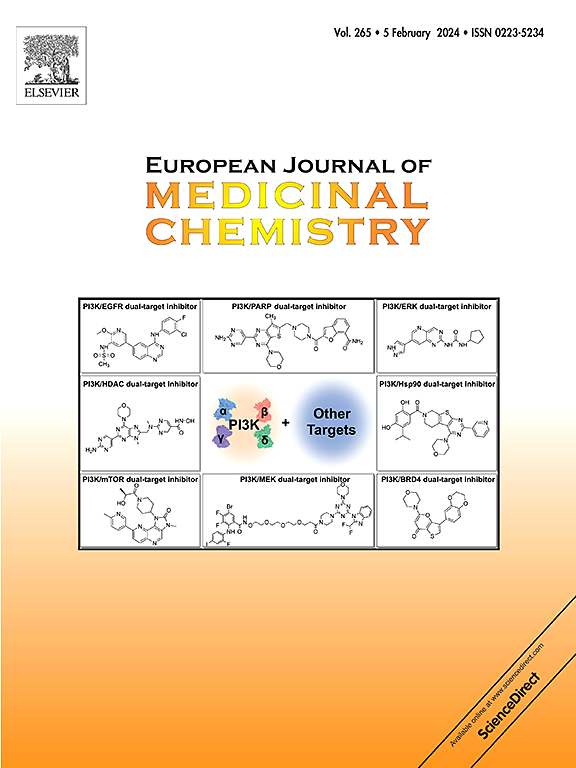发现3,4-二氢异喹啉-2(1H)-羧酰胺STING抑制剂作为抗炎药
IF 5.9
2区 医学
Q1 CHEMISTRY, MEDICINAL
引用次数: 0
摘要
干扰素基因刺激因子(STING)是一种内质网定位的连接蛋白,在介导细胞质dna感应途径启动先天免疫应答中起着至关重要的作用。过度激活的STING轴引起干扰素和促炎细胞因子的过度积累,导致自身免疫和自身炎症疾病,如婴儿期STING相关血管病变(SAVI)和Aicardi - gouti本文章由计算机程序翻译,如有差异,请以英文原文为准。


Discovery of 3,4-dihydroisoquinoline-2(1H)-carboxamide STING inhibitors as anti-inflammatory agents
Stimulator of interferon genes (STING) is an endoplasmic reticulum-localized adaptor protein that plays a vital role in mediating the cytosolic DNA-sensing pathway to prime the innate immune responses. Overactivated STING axis causes excessive accumulation of interferons and proinflammatory cytokines, leading to autoimmune and autoinflammatory diseases such as STING-associated vasculopathy of infancy (SAVI) and Aicardi−Goutières syndrome (AGS). Inhibiting the aberrant STING signaling with its inhibitors has proven to alleviate the inflammatory symptoms of the autoimmune and autoinflammatory diseases. Here we report the discovery of 3,4-dihydroisoquinoline-2(1H)-carboxamide STING inhibitors. Extensive structure-activity relationship (SAR) study allowed us to identify compound 5c with cellular human- and mouse-STING inhibitory IC50 values of 44 and 32 nM, respectively. It effectively inhibited the activation of the STING axis in both human and murine cells, potentially through covalent binding to the transmembrane domain of STING. Compound 5c also demonstrated robust in vivo anti-inflammatory efficacy on STING agonist-stimulated systemic inflammation and cisplatin-induced acute kidney injury (AKI) mice models. Further study revealed that 5c could restore renal mitochondrial function, suppress reactive oxygen species production, and reduce cell apoptosis to protect mice against cisplatin-induced AKI.
求助全文
通过发布文献求助,成功后即可免费获取论文全文。
去求助
来源期刊
CiteScore
11.70
自引率
9.00%
发文量
863
审稿时长
29 days
期刊介绍:
The European Journal of Medicinal Chemistry is a global journal that publishes studies on all aspects of medicinal chemistry. It provides a medium for publication of original papers and also welcomes critical review papers.
A typical paper would report on the organic synthesis, characterization and pharmacological evaluation of compounds. Other topics of interest are drug design, QSAR, molecular modeling, drug-receptor interactions, molecular aspects of drug metabolism, prodrug synthesis and drug targeting. The journal expects manuscripts to present the rational for a study, provide insight into the design of compounds or understanding of mechanism, or clarify the targets.

 求助内容:
求助内容: 应助结果提醒方式:
应助结果提醒方式:


